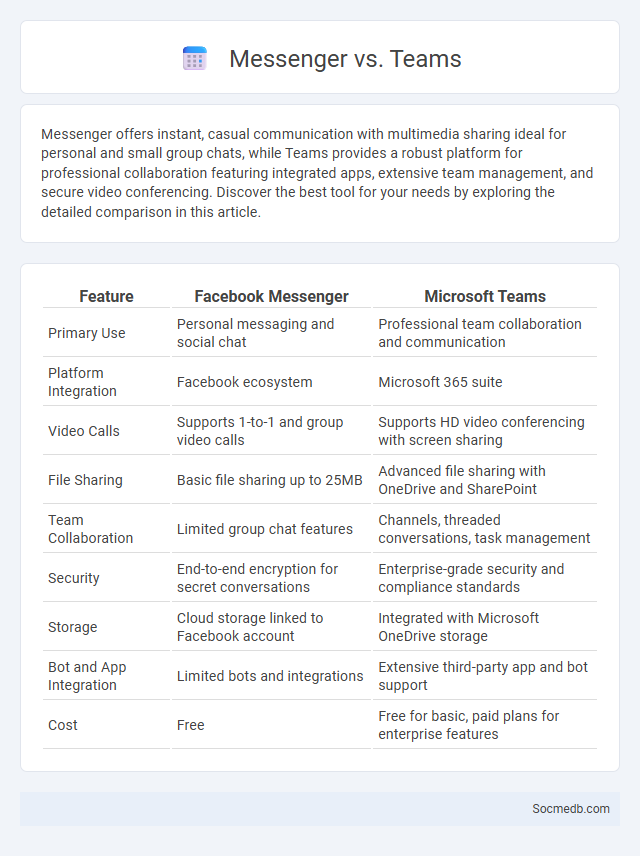
Photo illustration: Messenger vs Teams
Messenger offers instant, casual communication with multimedia sharing ideal for personal and small group chats, while Teams provides a robust platform for professional collaboration featuring integrated apps, extensive team management, and secure video conferencing. Discover the best tool for your needs by exploring the detailed comparison in this article.
Table of Comparison
| Feature | Facebook Messenger | Microsoft Teams |
|---|---|---|
| Primary Use | Personal messaging and social chat | Professional team collaboration and communication |
| Platform Integration | Facebook ecosystem | Microsoft 365 suite |
| Video Calls | Supports 1-to-1 and group video calls | Supports HD video conferencing with screen sharing |
| File Sharing | Basic file sharing up to 25MB | Advanced file sharing with OneDrive and SharePoint |
| Team Collaboration | Limited group chat features | Channels, threaded conversations, task management |
| Security | End-to-end encryption for secret conversations | Enterprise-grade security and compliance standards |
| Storage | Cloud storage linked to Facebook account | Integrated with Microsoft OneDrive storage |
| Bot and App Integration | Limited bots and integrations | Extensive third-party app and bot support |
| Cost | Free | Free for basic, paid plans for enterprise features |
Overview of Messenger, Teams, and Messenger Alternatives
Messenger and Teams are leading communication platforms designed to enhance collaboration and real-time messaging for businesses and personal use. Messenger offers seamless instant messaging, voice, and video calls primarily for social connections, while Teams integrates chat, video conferencing, and productivity tools tailored for workplace collaboration. Your choice among these and messenger alternatives like Slack or Discord depends on specific needs such as user interface preferences, integration capabilities, and scalability for group interactions.
Key Features Comparison: Messenger vs Teams
Messenger offers instant messaging, voice and video calls, and seamless integration with Facebook, supporting informal communication and social interactions. Teams provides robust collaboration tools such as threaded conversations, file sharing, integration with Microsoft 365 apps, and advanced meeting capabilities tailored for professional environments. Security features vary, with Teams offering enterprise-grade encryption and compliance options, while Messenger focuses on user-friendly encryption for personal chats.
User Interface and Experience
Social media platforms prioritize intuitive user interfaces (UI) that enhance user experience (UX) by offering seamless navigation and visually appealing layouts. Features such as interactive buttons, customizable feeds, and real-time notifications improve engagement and retention rates. Optimizing UI/UX with responsive design and accessibility standards ensures inclusivity and satisfaction across diverse user demographics.
Integration with Other Tools and Platforms
Effective social media strategies involve seamless integration with customer relationship management (CRM) systems, email marketing platforms, and analytics tools to enhance data synchronization and campaign efficiency. Integrating social media with e-commerce platforms like Shopify or WooCommerce facilitates direct sales tracking and targeted advertising based on user behavior. APIs and automation tools such as Zapier enable real-time cross-platform interactions, improving workflow automation and audience engagement.
Security and Privacy Considerations
Social media platforms constantly update their security protocols to protect user data from breaches and unauthorized access. Encryption technologies and two-factor authentication significantly reduce the risk of cyberattacks and identity theft on popular networks like Facebook, Instagram, and Twitter. Users must remain vigilant about privacy settings and avoid sharing sensitive information to minimize exposure to phishing scams and data mining practices.
Collaboration and Productivity Tools
Collaboration and productivity tools on social media platforms enhance teamwork through real-time communication, file sharing, and project management features. Integrations with apps like Slack, Trello, and Google Workspace streamline workflows, enabling seamless coordination across remote and distributed teams. These tools increase efficiency by centralizing tasks, fostering transparency, and supporting instant feedback loops in professional environments.
Pricing and Subscription Models
Social media platforms often utilize tiered subscription models offering free basic access alongside premium plans with enhanced features such as ad-free browsing, advanced analytics, and exclusive content. Pricing varies significantly, with platforms like LinkedIn Premium ranging from $29.99 to $99.99 per month and Twitter Blue priced at $8 per month, targeting professional and avid users respectively. These monetization strategies enable social media companies to diversify revenue streams beyond advertising by catering to varied user needs through flexible subscription options.
Ideal Use Cases for Each Platform
Instagram excels in visual storytelling, making it ideal for brands focusing on lifestyle, fashion, and food through high-quality images and short videos. LinkedIn suits B2B marketing and professional networking by sharing industry insights, company updates, and thought leadership content. Twitter is perfect for real-time news, customer engagement, and concise updates, enabling brands to participate in trending conversations and provide quick support.
Pros and Cons: Messenger vs Teams
Messenger offers a user-friendly interface and quick, casual communication ideal for informal conversations and instant messaging, enhancing your real-time social interaction. Teams excels in collaborative work environments by integrating chat, video calls, file sharing, and project management tools, boosting productivity and organization for professional group communication. Your choice depends on whether you prioritize casual social engagement or structured teamwork within digital communication platforms.
Which Messaging Platform Should You Choose?
Choosing the right messaging platform depends on your communication needs, target audience, and privacy preferences. Platforms like WhatsApp offer end-to-end encryption ideal for secure conversations, while Facebook Messenger integrates seamlessly with social media for broader engagement. Evaluate features such as group chat capability, multimedia support, and user base demographics to ensure your messaging platform aligns with your personal or business goals.
 socmedb.com
socmedb.com